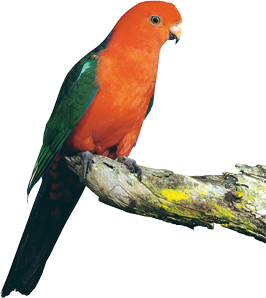Profiles
KING PARROT
(AlisterusScapularis)
Family: Parrot
Origin: Found along the eastern seaboard of Australia, from Victoria to Cooktown in Queensland.
Size: Length is 430mm including its glorious 200mm tail.
Description:
Parrots are often referred to as “flying rainbows” because of their many vibrant colours and the king parrot certainly lives up to this tag.
The male bird (cock) has a scarlet head and under parts. Its back and wings are dark green and the wings also have a pale green band. The rump is blue with a long, broad black-blue tail attached and the under tail coverts are red with very dark green crescents. Its upper beak is red and the lower part is black.
The head, upper breast and upper parts of the female (hen) are green but they do not always sport the green band on the wings like the male bird.
It has a blue rump with a long, broad tail with green crescents and under tail coverts. The upper beak is red and the lower beak is grey. The immature chicks are similar looking to the hen.
Care:
If you are planning to keep this particular parrot it should be housed in an aviary with a long flight. This bird is just too big to put in a cage and live inside the home.
In the wild king parrots breed in long, upright logs but nesting boxes (make sure they are tall) can be provided in captivity. It’s also a good idea to use wood shavings for nesting material but be sure to use those from non-poisonous trees and that are free of any toxins – this also includes treated timbers.
All food and water dishes need to be cleaned regularly (use only mild soaps and rinse off thoroughly). A large, shallow dish needs to be provided and filled with water so that the birds can take a bath and splash about.
Eats:
A good quality parrot mix including sunflower, safflower, oats, millets, canary seed and fresh fruit and vegetables that consists of apple, pear, orange, corn on the cob, celery, carrot, spinach, silver beet, cuttlefish bone and grit. Do not feed avocado as this is poisonous to birds.
Features: The hen usually lays three eggs and incubates them for 20 days. The male does not sit on the eggs but it does help feed the chicks once they have hatched.
The chicks then leave the nest after five weeks and immediately begin to fend for themselves. The adult plumage of a cock takes several months to come through after a number of slow moults.
Call:
This beautiful bird has a shrill call that is repeated often while in flight, but when they are resting on a perch it changes to a piping bell like note.
Personality:
King parrots are very wary birds and the slightest noise or disturbance will see them quickly take flight and calling to each other in a loud voice.
Living in the wild they are often the bane of many farmers as they will raid orchards and crops in large numbers and can therefore cause a lot of damage to these fruit and grain crops.
